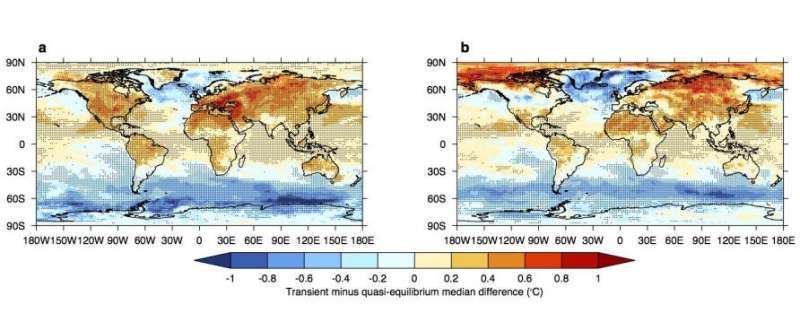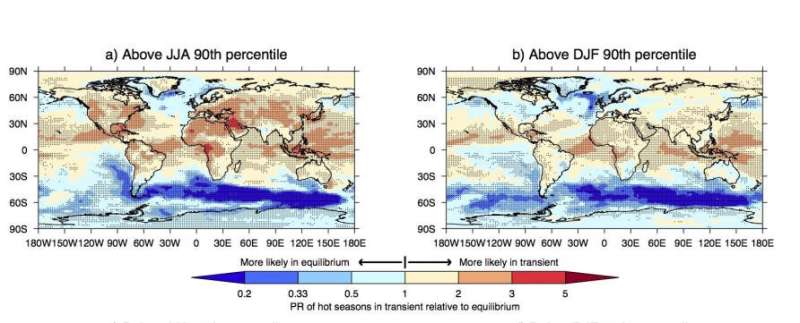How fast the planet warms will be crucial for livability

The world is warming … and fast. The global average temperature has already risen by more than 1°C as a result of greenhouse gas emissions from human activity, and most of that warming has come in just the last 50 years.
Given our projected greenhouse gas emissions, it's likely that the world will continue to warm for several decades yet and we're on track for global warming to reach around 3°C above pre-industrial temperatures by the end of the century.
In contrast, under the Paris climate agreement, we're aiming to limit global warming to under 2°C, and preferably 1.5°C, above pre-industrial levels. The global warming limits in the Paris Agreement are, at least implicitly, about stabilizing the climate whereas at the moment, we're on a pathway that in the next few decades will result in temperatures rapidly warming through these limits.
This begs the question of how different does the world look between a future where the climate warms rapidly in a consistent trend, compared to a future where temperatures rise more gradually and stabilize? This is a question we tried to answer in our recent study published in Nature Climate Change.
We compared two groups of global climate model simulations: one assuming rapid warming through the 21st Century, and another with slower warming that eventually stabilizes in the 23rd Century. By comparing these two different groups of climate simulations we could examine the effect of different rates of global temperature increases on the temperature patterns across the world.
And we found that the rate of temperature increase, irrespective of the absolute temperature rises, has significant implications for local climates.
In a rapidly-warming climate the land heats up faster than the ocean, but if the climate is given time to stabilize then the oceans start to catch up. This means that in a scenario of rapid warming, or what we call a "transient" climate, temperatures in many land areas are at least 0.5°C warmer on average compared with a stabilized climate even at the same level of global warming.
In contrast, some areas of the ocean, like the Southern Ocean and North Atlantic, take a long time to warm up so these areas are a lot cooler in a rapidly warming climate than in a comparable but stabilized warmer world.
This difference between rapidly warming and stabilized climates extends to temperature extremes too. In many populated areas around cities ranging from New York to Baghdad and from Istanbul to Tokyo, the probability of a hot summer is at least twice as high in a transient, or rapidly warmer world, than in a stabilized warmer climate at the same level of global warming.
Why does this matter?

It is clear that in a rapidly warming world as we pass through the 1.5°C global warming level, we would have a very different climate than if we were to achieve the Paris Agreement goals and limit global warming to 1.5°C. So, even though we're talking about the same level of global warming, the regional impacts are very different depending on the pace of warming.
For temperature extremes, stabilizing the climate would be beneficial as we would have fewer land-based heatwaves and hot seasons.
In fact for some areas of the world, if we were to achieve the Paris Agreement goal of stabilizing the climate at 1.5°C global warming, we would experience cooler average summer temperatures and fewer hot summers than we do in our current rapidly warming world after 1.1°C of human-induced global warming.
This difference in temperature patterns depending on the rate of global warming that we've highlighted in our study has been under-appreciated previously. Studies of future warmer worlds that were included in the recent Intergovernmental Report on Climate Change (IPCC) report on the Paris Agreement 1.5°C limit used model simulations at various rates of global warming. This means that on regional scales they are not comparable.
Both types of studies are useful: analyses of 1.5°C or 2°C transient global warming tell us about the world we're likely to experience in the next few decades, whereas analyses of 1.5°C or 2°C stabilized global warming inform us about how the world might look if we achieve the Paris Agreement.
However, there is a risk of poor policy making if, for example, policies to limit emissions and mitigate climate change are based solely on gradual and stabilizing warming, when the potential for more rapid warming may imply more urgent or drastic action. Scientists need to clearly frame their studies to reduce the risk of misinterpretation by decision-makers.
Our study shows that the rate of global warming has a large effect on the pattern of warming. If we do manage to stabilize our climate and meet the Paris Agreement goals we will benefit from fewer hot summers, and, in some populated areas, we should see a reduction in heat extremes relative to today's climate as well.
This should be another incentive to reduce greenhouse gas emissions and stabilize the global climate.
More information: Andrew D. King et al. Global and regional impacts differ between transient and equilibrium warmer worlds, Nature Climate Change (2019). DOI: 10.1038/s41558-019-0658-7
Journal information: Nature Climate Change
Provided by University of Melbourne





















